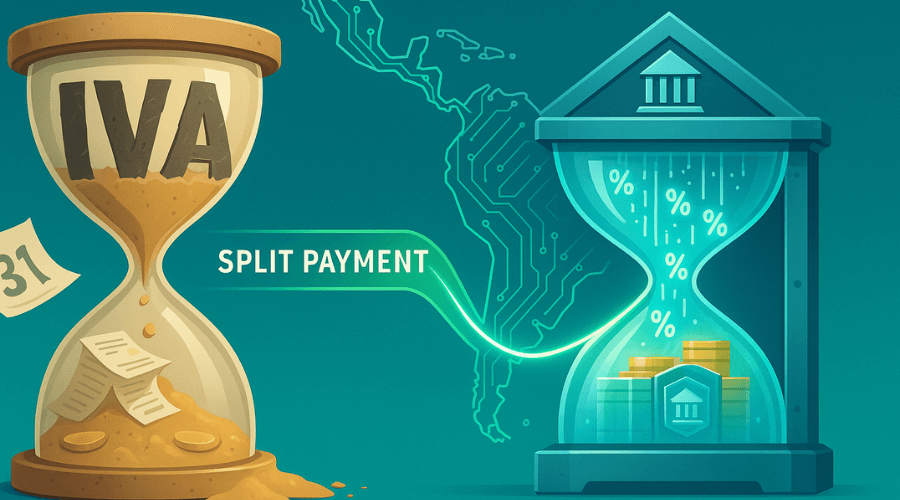Are VAT’s days numbered? How split payment can transform the consumption taxation?

The Value Added Tax (VAT) has been, for decades, the backbone of modern tax systems in terms of consumption taxation. Adopted in more than 160 countries, VAT has proven effective in generating stable income, ensuring economic neutrality and facilitating control in analogue environments. However, rapid technological advances are challenging its supremacy. Could VAT be nearing the end of its cycle as the predominant model?
Although VAT is based on an elegant principle – to tax the added value at every stage of the production process – its implementation, in practice, generates important frictions. Companies face high compliance costs, due to the need to record tax credits and debits, issue valid invoices, manage returns and anticipate audits. Those costs are proportionately higher for SMEs, but they also negatively impact the operations of large companies. In addition, the impact on business liquidity (companies must pay VAT on their inputs at the time of purchase but only recover that value when they manage to sell) especially affects firms that operate on tight margins or long rotation cycles. In short, VAT administrative costs reduce the efficiency of the system.
The proliferation of digital payments, the widespread use of electronic invoicing, and the use of artificial intelligence (AI) and blockchain in tax administration have changed the game. In this new environment, it is technically feasible to collect consumption tax in real time, at the same time the transaction occurs. In addition, with the development of Central Bank Digital Currencies (CBDCs), one of the main evasion doors can be closed by limiting or eliminating cash transactions. If all payments became digital and programmable, evasion would tend to zero. AI systems could even automatically validate transactions and classify products and services to apply the correct final sales tax rate. This change opens the door to an alternative model: the split payment sales tax. In this system, the part corresponding to the tax is automatically separated from the payment made by the buyer and transferred directly to the tax authorities. The selling company receives only the net value.
Italy has implemented a split payment mechanism in certain transactions with public entities since 2015. The UK has also announced its interest in exploring a similar system, applicable to international e-commerce. Although still incipient, these cases illustrate that it is no longer a theoretical idea. The European Commission has studied its feasibility as a solution to combat VAT fraud.
In Latin America, CIAT and its member countries have developed advanced technological infrastructures that could facilitate the transition to new collection models. In December 2023, Brazil approved the tax reform, which replaces previous taxes with the Tax on Goods and Services (IBS) and the Contribution on Goods and Services (CBS). The regulations provide, among the forms of payment, the use of split payment applicable within the new VAT regime, although its operational implementation has not yet begun.
The advantages of this model must be strong: reduction of fraud, lower administrative burden, instant collection, total traceability and greater efficiency for companies. Instead of managing tax credits and refunds, companies would operate in an environment free of these processes, which represents a direct saving in personnel, systems and time.
However, a change of this caliber is not without risks. There are technical, legal and political challenges. For example, in the treatment of transactions between companies (B2B), if split payment is applied, there is a risk of generating cascading effects. One option is to exempt B2B operations, but that requires a secure identification of registered businesses. Another option is to maintain the split payment and enable immediate credit mechanisms, which imposes demands on the operational capacity of the administration.
Other challenges include the management of credits accumulated under the previous regime, the distribution of collection between levels of government, since, in federations, the design of the system must ensure that subnational entities do not lose revenue or tax autonomy, etc. It is essential that before moving forward, the expected tax impacts are modelled, considering elasticities, behavioral reactions and sectoral effects. The existence of detailed databases, such as those generated by electronic invoicing, can facilitate this type of analysis.
Countries such as Brazil, Mexico and Chile have already developed advanced digital platforms for VAT control. This puts them in a privileged position to lead split payment experiments or pilots, at least in specific sectors or in operations with the State. While replacing VAT entirely with a new automated sales tax may not be feasible in the short term, it may be possible to imagine a progressive transition that takes advantage of existing infrastructure.
VAT has undoubtedly been a fundamental pillar of the modern tax system. But its design responds to an analog economic reality that is disappearing. In a world where transactions are digital, payments are instant and tax administrations have sophisticated technological tools, the cost of maintaining a complex and bureaucratic system such as VAT can outweigh its benefits.
That is why I am wondering: Can the split payment model be its natural replacement in a digital environment? What additional barriers should we anticipate? We invite readers to leave their comments and share their perspectives on this possible transformation of consumption taxes.
Note: This text was written with the support of artificial intelligence tools (ChatGPT – OpenAI), under the review and edition of the author.
Selected references:
Brazil (2023) Lei Complementar n.º 214, de 16 de Janeiro de 2025, art. 27, III. It deals with IBS and CBS and allows the use of split payment. Diario Oficial da União, Brasilia.
European Commission. (2017). Analysis of the Impact of the Split Payment Mechanism as an Alternative VAT Collection Method.
OECD. (2023) Tax Administration 2023: Comparative Information on OECD and Other Advanced and Emerging Economies.
Louvieris, P., Ioannou, G., & White, G. (2024). Making Tax Smart: Feasibility of Distributed Ledger Technology for Building Tax Compliance Functionality into Central Bank Digital Currency.
5,626 total views, 24 views today

